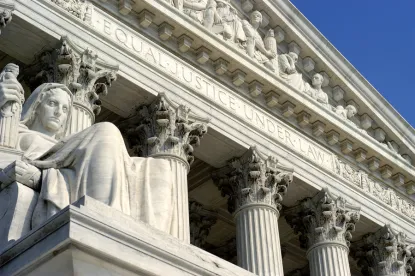Greetings, Court Fans!
The Nine returned to the bench this week (well, eight of them did, while Justice Ginsburg, recovering from cancer surgery, missed oral arguments for the first time in her quarter-century tenure) and handed down two unanimous opinions, two per curiam summary reversals, and six new cert grants. All in all, a busy week, so let’s get right to it.
They say with Supreme Court opinions, as with Campari, “you’ll never forget your first time.” Long then will Justice Kavanaugh remember Schein v. Archer & White Sales (No. 17-1272), his first opinion for the Court, and the Court’s one billionth (est.) addressing the scope of arbitration agreements under the Federal Arbitration Act. This time the Court addressed the arbitrability of so-called “gateway” questions—that is, who gets to decide whether an arbitration agreement governs a dispute in the first place. The Supreme Court has previously held that the parties to a contract may agree to have an arbitrator decide gateway questions, but several circuits have carved out an exception where the argument that a dispute is arbitrable is “wholly groundless.” Here, Archer & White sued Schein in federal court raising federal and state antitrust claims and seeking injunctive relief. Schein sought to compel arbitration, but Archer & White opposed, noting that the arbitration agreement between the parties contained an exception for actions seeking injunctive relief. Schein countered that the contract gave the arbitrator, not the court, the power to decide the gateway arbitrability question. The District Court sided with Archer & White, concluding that Schein’s argument that the dispute is subject to arbitration was wholly groundless. The Fifth Circuit agreed, exacerbating a circuit split over the FAA permits this “wholly groundless” exception to arbitrability.
The Supreme Court reversed. Writing for a unanimous Court, Justice Kavanaugh found that the FAA does not allow for a “wholly groundless” exception for threshold arbitrability questions. The text of the Act allows parties to contract to delegate arbitrability questions to an arbitrator—regardless of whether the argument that the matter is arbitrable is good, bad, or very bad. Justice Kavanaugh relied on the general principle from AT&T Technologies, Inc. v. Communications Workers (1960) that, under the FAA, courts shouldn’t weigh in on the merits of an arbitrable claim, even if the court thinks one side’s arguments are frivolous. Ditto, Justice Kavanaugh said, for threshold arbitrability questions. He declined what he saw as an invitation by Archer & White to “redesign” the FAA. In any event, Justice Kavanaugh argued, Archer & White’s policy arguments—that the wholly-groundless exception promotes efficiency and is necessary to deter the filing of frivolous motions to compel arbitration—are overstated. Arbitrators are perfectly capable of efficiently disposing of frivolous cases and deterring frivolous motions to compel, and there has not been a problem in those circuits that had not recognized a “wholly groundless” exception. Ultimately, Kavanaugh concluded, “[w]hen the parties’ contract delegates the arbitrability question to an arbitrator, the courts must respect the parties’ decision.”
The Court was also unanimous in Culbertson v. Berryhill (No. 17-773), addressing the Social Security Act’s cap on fees that attorneys may charge to claimants seeking Title II benefits before the Social Security Administration and in federal court. The Act contains separate 25% fee caps (§406(a) and §406(b)) for representation at the administrative and judicial-review stages. The question in Culbertson was whether the 25% fee cap on fees for representation at the judicial-review stage limits the aggregate fees awarded for representation in both phases, or only the fee awarded for court representation. The Eleventh Circuit held that the 25% limit on fees for court representation applies to the total fees awarded in both phases, “preclud[ing] the aggregate allowance of attorney’s fees greater than twenty-five percent of the past due benefits received by the claimant.”
The Supreme Court reversed. In a unanimous opinion, Justice Thomas zeroed in on the statutory text. Section 406(b) states that when a court “renders a judgment favorable to a claimant . . . who was represented before the court by an attorney,” the court may award “a reasonable fee for such representation, not in excess of 25 percent of the total of the past-due benefits to which the claimant is entitled by reason of such judgment.” The adjective “such” means “of the kind or degree already described or implied.” Because the only form of representation “already described” in §406(b) is “representat[ion] before the court,” the sections 25% cap applies only to fees for representation before the court, not any prior representation before the agency. This plain reading of the text was supported by the structure of the statute, as well, Justice Thomas argued. Sections 406(a) and 406(b) address different stages of representation and a claimant who prevails before the agency need not bring a court action. It, therefore, makes sense that the fee provisions, including the caps, would be treated separately. So much sense, in fact, that even the Social Security Administration did not defend the Eleventh Circuit’s judgment. The Court, therefore, appointed an amicus to argue in favor of the judgment, but found “despite the force of [her] arguments, the statute does not bear her reading.”
The Court also issued two per curiam opinions summarily reversing two of the usual suspects—the Sixth and the Ninth Circuits—on two of the usual topics—qualified immunity and habeas corpus. First, in City of Escondido v. Emmons (No. 17-1660), the Court once again rebuked the Ninth Circuit for its habit of defining “clearly established” statutory or constitutional rights at too high a level of generality. The case was brought by Marty Emmons, the father of a woman who had called the police to report a domestic-violence incident involving her husband. While police officers were surrounding the home and attempting to gain access to conduct a welfare check, Emmons walked out the front door, ignored a command to leave the door open, and brushed past one of the officers. The officer immediately tackled him to the ground and handcuffed him. Emmons sued the officers for excessive force, but the District Court granted summary judgment on the basis of qualified immunity, finding that there was no clearly established law prohibiting the take-down under the circumstances, where the officers did not know that Emmons was not the domestic assailant and did not know whether he was armed or dangerous. The Ninth Circuit reversed, concluding that “[t]he right to be free of excessive force was clearly established at the time of the events in question.” That one-sentence analysis didn’t cut it with the Supreme Court. Citing a string of recent cases, the Court reiterated that it “has repeatedly told courts . . . not to define clearly established law at a high level of generality,” particularly in excessive force cases. Here, the Ninth Circuit “should have asked whether clearly established law prohibited the officers from stopping and taking down a man in these circumstances,” rather than whether there is a general right to be free from excessive force. The Court remanded the case to the Ninth Circuit to conduct the proper analysis.
Second, in Shoop v. Hill (No. 18-56), the Court vacated the Sixth Circuit’s grant of habeas relief to an Ohio prisoner on death row, because the Sixth Circuit had improperly relied on a 2017 Supreme Court decision in deciding whether 2009 decisions by the Ohio state courts had wrongly applied clearly established Supreme Court precedent. In 1986, Danny Hill was convicted of the gruesome murder of a young boy and sentenced to death. His conviction and sentence were affirmed by the Ohio intermediate appellate and supreme courts. Years later, he filed a petition in the Ohio courts seeking postconviction relief, arguing that his death sentence was illegal under Atkins v. Virginia (2002), which held that the Eighth Amendment prohibits the imposition of a death sentence on a defendant who is “mentally retarded.” The Ohio state courts denied his claim in 2009. Hill then filed a federal habeas petition. As habeas buffs well know, federal habeas petitions are generally limited to the question of whether a state court’s denial of post-conviction relief was “contrary to or an unreasonable application of clearly established” federal law. Hill argued that the Ohio courts had unreasonably applied Atkins to the facts of his case. The Sixth Circuit agreed, but in doing so, it relied primarily on Moore v. Texas (2017), an opinion that obviously post-dated the Ohio courts’ 2009 decisions. The Sixth Circuit recognized that Supreme Court opinions that post-date a state court’s decision are generally not “clearly established law” for the purposes of the federal habeas statute, but reasoned that Moore was simply an “application” of what Atkins had already clearly established. A unanimous Supreme Court disagreed: Moore did more than simply apply Atkins to a particular set of facts; it established a different legal standard for what counts as an intellectual disability for the purposes of the Eighth Amendment. And Hill’s habeas petition was litigated in light of the standard established in Atkins; it was not until the Sixth Circuit asked for supplemental briefing on appeal that anyone addressed the standard established in Moore. Accordingly, the Court remanded the case to the Sixth Circuit to determine whether the Ohio courts had unreasonably applied law that was clearly established at the tim they denied Hill postconviction relief in state court.
Finally, we’ve got six new cert grants to report. The two getting the most attention are Rucho v. Common Cause (No. 18-422) and Lamone v. Benisek (No. 18-726), which both address the question of whether state officials violate the Constitution by drawing legislative districts to favor one political party, so-called partisan gerrymandering. If that issue sounds familiar, it should. Last term, the Supreme Court granted cert in two cases addressing the same issue: Gill v. Whitford and Benisek v. Lamone. Both times, though, the Court ducked a decision on the merits. In Gill, the Court remanded the case to the lower courts to determine whether the plaintiffs had standing to challenge Wisconsin’s legislative districts. On the same day, the Court sent Benisek back to the District Court, concluding that the plaintiffs had waited too long to seek a preliminary injunction prohibiting Maryland officials from using the established legislative districts for the 2018 elections. On remand, the District Court held that the redrawing of one legislative district to favor Democratic candidates was unconstitutional. Around the same time, a three-judge district court in North Carolina held that the state’s Republican-favoring districts were also unconstitutional. The Supreme Court will now review both cases (Rucho from North Carolina and Lamone back from Maryland), with oral argument scheduled in March, giving them relatively little time to decide one of the most hotly debated topics of the day in election law. But there’s no guarantee the Court will end up reaching the merits this time either: Both Rucho and Lamone have some of the same standing issues that beguiled Gill, giving the Justices an out if they are unwilling or unable to reach the merits.
Another case that may sound familiar is Iancu v. Brunetti (No. 18-302), which asks whether a federal law banning the registration of “immoral” or “scandalous” trademarks violates the First Amendment. Brunetti tried to register the trademark “FUCT” for his clothing line, but the U.S. Patent and Trademark Office rejected his application. The Federal Circuit reversed, relying heavily on the Supreme Court’s recent decision in Matal v. Tam (2017), which unanimously held that a similar federal law banning the registration of trademarks that “disparage” persons violates the First Amendment. Although the result in Matal was unanimous, its application to other contexts is far from clear, because the Justices split 4-4 regarding the standard of review. Iancu thus gives the Court a chance to clarify how Matal applies to other limits on trademark registrations that discriminate against certain speech on the basis of content.
United States v. Davis (No. 18-431) will also give some readers déjà vu. It asks whether the subsection-specific definition of “crime of violence” in the Armed Career Criminal Act is unconstitutionally vague. If that sounds familiar, it’s because the Supreme Court has already decided, in Johnson v. United States (2015), that a different provision of the ACCA defining a “violent felony” is unconstitutionally vague and, in Sessions v. Dimaya (2018)that a similar “crime of violence” definition in the Immigration and Nationality Act is unconstitutionally vague. Put them together and its fair to say the odds are stacked against the Government here, but time will tell.
Next, in Emulex Corp. v. Varjabedian (No. 18-459), the Court granted cert on a question of the Securities Exchange Act of 1934 that has divided the federal courts of appeals. The Act gives plaintiffs a private right of action for false statements or significant omissions made in connection with a tender offer. Five courts of appeal have required plaintiffs to show that the person making the statement intended to make the false statement. But the Ninth Circuit concluded that it was enough for a plaintiff to show that the person made the false statement negligently.
Last (and, let’s face it, least) the Court granted cert in a bankruptcy case: Taggart v. Lorenzen (No. 18-489). A “discharge” in bankruptcy generally prohibits creditors from attempting to collect discharged debts, and creditors who violate the discharge can be held in contempt. In Taggart, the Ninth Circuit held that a creditor who believes in good faith that the discharge did not apply to the debts sought could not be held in contempt, even if the creditor’s belief was unreasonable. In doing so, it disagreed with the Eleventh Circuit, which has held that a creditor’s good faith is irrelevant.





 />i
/>i

